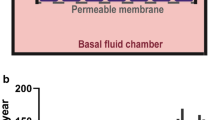Abstract
Drug transport through the tight-junctional pathway in Caco-2 monolayer was studied by examining the relationship between its permeability to hydrophilic drugs and membrane conductance. Compared with the rat isolated jejunum or colon, Caco-2 monolayer displayed high electrical resistance and low conductance, as well as low permeability to sulfanilic acid and FITC-dextran (M.W. 4000). However, there was a linear relationship between the drug permeability and partial Cl− ion conductance for Caco-2 monolayer, rat jejunum and colon. Hence, the permeability to those drugs per unit of Cl− conductance is similar in the three membranes, suggesting that the size (radius) of the tight-junctional pathway in the three membranes is similar. In addition, when the electrical resistance of Caco-2 monolayer was reduced to the same level as that of the jejunum or colon by pretreatment with disodium ethylenediamine-tetraacetate, its permeability to FITC-dextran became significantly higher than that of other membranes. Accordingly, the high resistance and the low permeability of Caco-2 monolayer compared with rat intestinal membrane may be due to structural differences between the membranes, rather than a difference in the tightness of the junction.
Similar content being viewed by others
REFERENCES
M. J. Jackson, C. Y. Tai and J. E. Steane. Weak electrolyte permeation in alimentary epithelia. Am. J. Physiol. 240, G191–G198 (1981).
G. Barnett, S. Hui and L. Z. Benet. Effects of theophylline on salicylate transport in isolated rat jejunum. Biochim. Biophys. Acta. 507, 517–528 (1978).
D. W. Powell. Barrier function of epithelia. Am. J. Physiol. 241, G275–288 (1981).
S. Yamashita, M. Takahashi, M. Masada, T. Nadai, A. Kobayashi, Y. Kurosaki, T. Nakayama and T. Kimura. Effect of experimental acute renal failure on barriers to permeation of a polar drug in rat jejunum: an electrophysiological study. Chem. Pharm. Bull. 36, 2538–2543 (1988).
S. Yamashita, H. Saitoh, K. Nakanishi, M. Masada, T. Nadai and T. Kimura. Effect of diclofenac sodium and disodium ethylenediaminetetraacetate on electrical parameters of the mucosal membrane and their relation to the permeability enhancing effects in the rat jejunum. J. Pharm. Pharmacol. 39, 621–626 (1986).
A. R. Hilgers, R. A. Conradi and P. S. Burton. Caco-2 cell monolayers as a model for drug transport across the intestinal mucosa. Pharm. Res. 7, 902–910 (1990).
G. Wilson, I. F. Hassan, C. J. Dix, I. Williamson, R. Shah, M. Mackay and P. Artursson. Transport and permeability properties of human Caco-2 cells: an in vitro model of the intestinal epithelial cell barrier. J. Controlled Release 11, 25–40 (1990).
P. Artursson and J. Karlsson. Correlation between oral drug absorption in humans and apparent drug permeability coefficients in human intestinal epithelial (Caco-2) cells. Biochem. Biophys. Res. Commun. 175, 880–885 (1991).
I. J. Hidalgo, T. J. Raub and R. T. Borchardt. Characterization of the human colon carcinoma cell line (Caco-2) as a model system for intestinal epithelial permeability. Gastroenterology 96, 736–749 (1989).
A. Blais, P. Bissonnette and A. Berteloot. Common Characteristics for Na+-dependent sugar transport in Caco-2 cells and human fetal colon. J. Membrane Biol. 99, 113–125 (1987).
I. J. Hidalgo and R. T. Borchardt. Transport of a large neutral amino acid (phenylalanine) in a human intestinal epithelial cell line: Caco-2. Biochim. Biophys. Acta. 1028, 25–30 (1990).
A. H. Dantzig and L. Bergin. Uptake of the cephalosporin, cephalexin, by a dipeptide transport carrier in the human intestinal cell line, Caco-2. Biochim. Biophys. Acta. 1027, 211–217 (1990).
P. Artursson. Epithelial transport of drugs in cell culture. I: A model for studying the passive diffusion of drugs over intestinal absorbtive (Caco-2) Cells. J. Pharm. Sci. 79, 476–482 (1990).
P. Artursson, A. L. Ungell and J. E. Lofroth. Selective paracellular permeability in two models of intestinal absorption: Cultured monolayers of human intestinal epithelial cells and rat intestinal segments. Pharm. Res. 8, 1123–1129 (1993).
T. Kimura, S. Yamashita, K. S. Kim and H. Sezaki. Electrophysiological approach to the action of taurine on rat gastric mucosa. J. Pharm. Dyn. 5, 495–500 (1982).
H. N. Nellans, R. A. Frizzell and S. G. Schultz. Brush-border processes and transepithelial Na and Cl transport by rabbit ileum. Am. J. Physiol. 226, 1131–1141 (1974).
S. Yamashita, M. Masada, T. Nadai and T. Kimura. Effect of adjuvants on charge-selective permeability and electrical resistance if rat jejunal membrane. J. Pharm. Sci. 79, 579–583 (1990).
T. Kimura, K. S. Kim and H. Sezaki. Effect of taurine on drug absorption from the rat gastrointestinal tract. J. Pharmacobio Dyn. 4, 35–41 (1981).
J. H. Moreno and J. M. Diamond. Discrimination of monovalent inorganic cations by “Tight” junctions of gallbladder epithelium. J. Membrane Biol. 15, 277–318 (1974).
M. Tomita, M. Hayashi and S. Awazu. Comparison of absorption-enhancing effect between sodium caprate and disodium ethylenediaminetetraacetate in Caco-2 cells. Biol. Pharm. Bull. 17, 753–755 (1994).
J. R. Pappenheimer. Passage of molecule through capillary walls. Physiol. Rev. 33, 387–423 (1953).
P. G. Ruifrok and W. E. Mol. Paracellular transport of inorganic and organic ions across the rat ileum. Biochem. Pharmacol. 32, 637–640 (1983).
P. H. Barry and J. M. Diamond. A theory of ion permeation through membranes with fixed neutral sites. J. Membrane Biol. 4, 295–330 (1971).
M. M. Cassidy and C. S. Tidball. Cellular mechanism of intestinal permeability alterations produced by chelation depletion. J. Cell Biol. 32, 685–697 (1967).
T. Murakami, N. Yata, H. Tamauchi and H. Kamada. Studies of absorption promoters for rectal delivery preparations. II. A possible mechanisms of promoting efficacy of enamine derivatives in rectal absorption. Chem. Pharm. Bull. 30, 659–665 (1982).
Rights and permissions
About this article
Cite this article
Tanaka, Y., Taki, Y., Sakane, T. et al. Characterization of Drug Transport Through Tight-Junctional Pathway in Caco-2 Monolayer: Comparison with Isolated Rat Jejunum and Colon. Pharm Res 12, 523–528 (1995). https://doi.org/10.1023/A:1016245711557
Issue Date:
DOI: https://doi.org/10.1023/A:1016245711557



